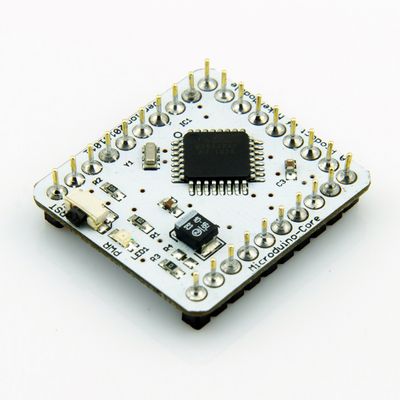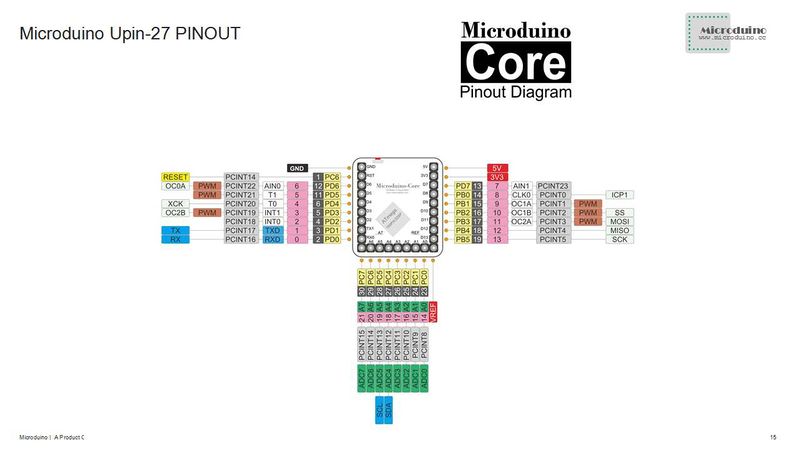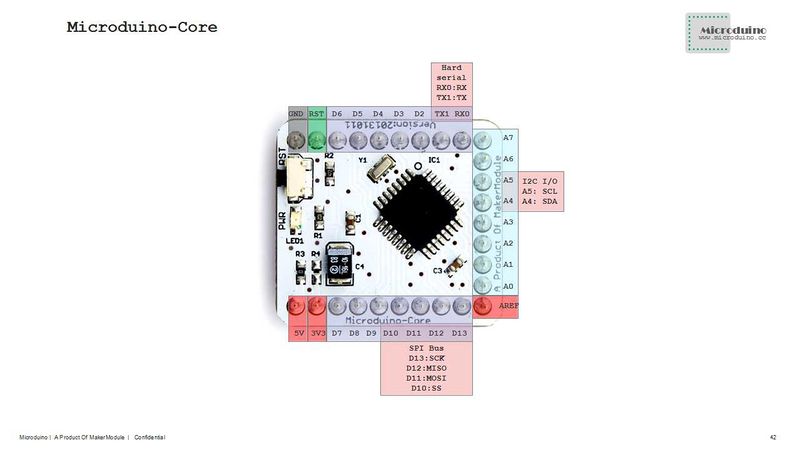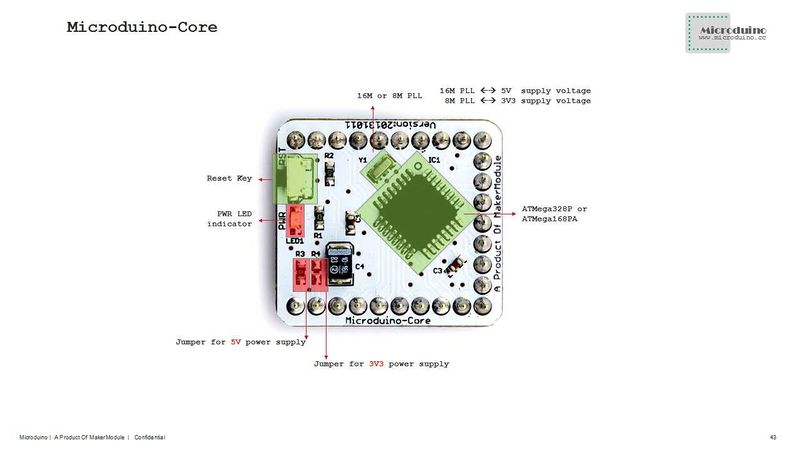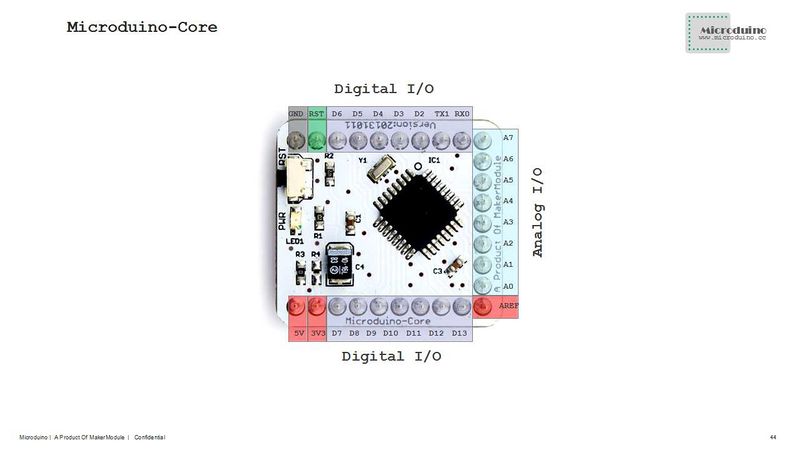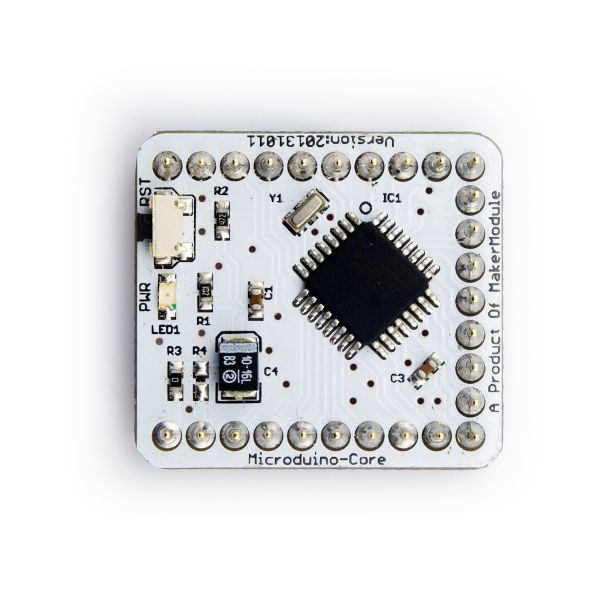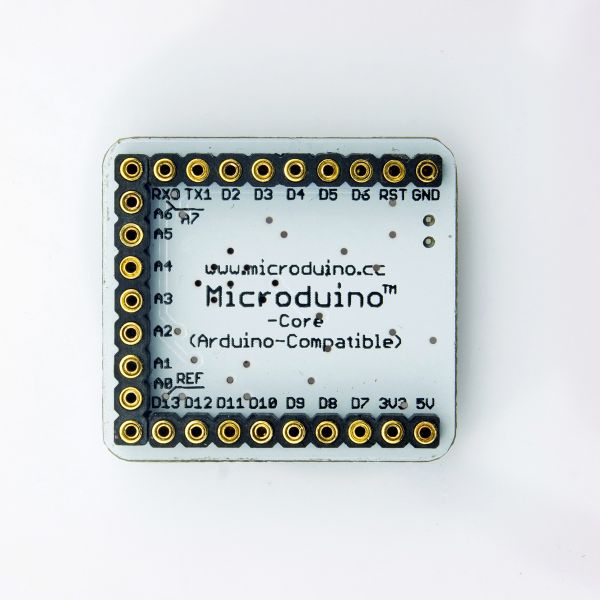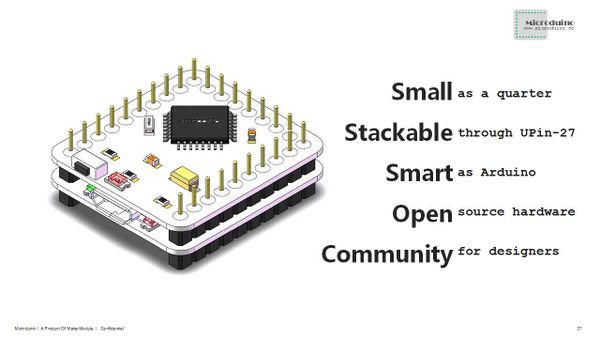|
|
| Line 138: |
Line 138: |
| | * Microcontroller: ATmega328P/ATmega168PA | | * Microcontroller: ATmega328P/ATmega168PA |
| | * Operating Voltage: 5V/3.3V | | * Operating Voltage: 5V/3.3V |
| − | * Input Voltage (limits): 6-20V
| |
| | * Digital I/O Pins: 14 (of which 6 provide PWM output with D3,D5,D6,D9,D10 and D11) | | * Digital I/O Pins: 14 (of which 6 provide PWM output with D3,D5,D6,D9,D10 and D11) |
| | * Analog Input Pins: 8 (2 more comparing to Arduino Uno) | | * Analog Input Pins: 8 (2 more comparing to Arduino Uno) |
|
Microduino-Core is one of core modules of Microduino series, Microduino-Core is an open source hardware and Arduino Uno compatible. It is an 8-bit microcontroller development board, based on Atmel ATmega328P/ATmega168PA series.
Comparing to Arduino Uno, Microduino-Core is featured by:
- Microduino splits Arduino Uno into two parts: Microduino-Core and Microduino-FT232R modules -- MCU and USB2TTL parts. it means once designers uploaded program into Microduino-Core, Microduino-FT232R will be not necessary anymore, designers could have many Microduino-Core/Core+ modules with only one Microduino-FT232R. The board size becomes very small as only 25.4mm X 27.94mm (1.0inch X 1.1inch), like a quarter.
- Microduino series uses the U-Shape 27-pin interface (UPin-27), the standard interface of Microduino, all Microduino modules and sensors can be easily stacked and extended, it is delivered ready to plug in.
- With tiny shape and uniform interface, Microduino series dramatically decreases the size and cost of design prototype, remarkable improves usability and flexibility of Arduino-compatible boards, as well as user experience.
Microduino uses the same development environment as Arduino IDE, designers can use the Arduino IDE, Processing on Microduino for idea realization, prototype development and low volume production.
Microduino uses optiboot for bootloader, it takes less Flash than Arduino default engine and optimizes program uploading.
Currently, there are 4 different configurations for Microduino-Core modules:
| Type
|
Flash
|
SRAM
|
EEPROM
|
Frequency
|
Supply
|
| Atmega328P@16M,5V
|
32K
|
2K
|
1K
|
16M
|
5.0V
|
| ATmega328P@8M,3V3
|
32K
|
2K
|
1K
|
8M
|
3.3V
|
| ATmega168PA@16M,5V
|
16K
|
1K
|
512
|
16M
|
5.0V
|
| ATmega168PA@8M,3V3
|
16K
|
1K
|
512
|
8M
|
3.3V
|
Different configurations in frequency and supply voltage:
- Clock frequency and supply voltage are paired, 8M module is supplied by 3.3V voltage, while 16M module is by 5.0V voltage.
- A 16M with 5V Microduino-Core module is recommended for desktop equipments or designs; regarding mobile equipments or designs, a 8M with 3.3V module is suggested for low power and battery supply purposes.
|
Core vs Core+
- Microduino also provides Microduino-Core+ module, aiming at high performance applications which require large SRAM/EEPROM/Flash and more I/O ports.
- Both Microduino-Core and Microduino-Core+ use UPin-27 interface -- the standard module interface of Microduino series. The main difference between them is MCU chip: -Core module uses ATmega328P/ATmega168PA, as same as Arduino Uno; -Core+ module uses ATmega644PA/ATmega1284P, its performance is similar to Arduino Mega2560.
| Microduino
|
Chip
|
Flash
|
SRAM
|
EEPROM
|
Digital I/O
|
Analog I/O
|
PWM
|
Hardware Serial
|
| Core
|
Atmega168PA
|
16K
|
1K
|
512
|
23
|
8
|
6
|
1
|
| ATmega328P
|
32K
|
2K
|
1K
|
23
|
8
|
6
|
1
|
| Core+
|
Atmega644PA
|
64K
|
4K
|
2K
|
32
|
8
|
6
|
2
|
| ATmega1284P
|
128K
|
16K
|
4K
|
32
|
8
|
6
|
2
|
- According above table, Core and Core+ are different in Flash, EEPROM and SRAM size, also, they supply different size of digital I/O and hardware serial ports, and there are 10 more digital I/O and 1 more hardware serial ports in Core+. Designers can select specific module regarding different application requirements on function, performance and power.
- Both Core and Core+ use UPin-27 interface, Microduino program can be smoothly ported between them.
|
Features
- Small, Stack, Strong
- Open source hardware, using the same development environment as Arduino IDE
- Microduino-Core can be burned with ISP, same as Arduino, easy "bootloader"
- Using the U-Shape 27-pin interface (UPin-27), the standard interface of Microduino, all
Microduino modules and sensors can be easily stacked and extended through it
- Delivered ready to plug in.
- 2.54mm (0.1 inch) pin pitch, compatible to bread board and hole board
|
Specifications
- Microcontroller: ATmega328P/ATmega168PA
- Operating Voltage: 5V/3.3V
- Digital I/O Pins: 14 (of which 6 provide PWM output with D3,D5,D6,D9,D10 and D11)
- Analog Input Pins: 8 (2 more comparing to Arduino Uno)
- DC Current per I/O Pin: 40 mA
- DC Current: 50 mA
- Serial: 0 (RX) and 1 (TX). Used to receive (RX) and transmit (TX) TTL serial data.
- External Interrupts: 2 and 3. These pins can be configured to trigger an interrupt on a low value, a rising or falling edge, or a change in value. See the attachInterrupt() function for details.
- PWM: 3, 5, 6, 9, 10, and 11. Provide 8-bit PWM output with the analogWrite() function.
- SPI: 10 (SS), 11 (MOSI), 12 (MISO), 13 (SCK). These pins support SPI communication using the SPI
library.
- TWI: A4 or SDA pin and A5 or SCL pin. Support TWI communication using the Wire library.
- AREF. Reference voltage for the analog inputs. Used with analogReference().
- Flash Memory 32 KB (ATmega328P) of which 0.5 KB used by bootloader
- SRAM 2 KB (ATmega328P)
- EEPROM 1 KB (ATmega328P)
- Clock Speed 16MHz(5V) / 8Mhz(3.3V)
- Currently, there are 4 different configurations for Microduino-Core modules:
| Type
|
Flash
|
SRAM
|
EEPROM
|
Frequecy
|
Supply
|
| Atmega328P@16M,5V
|
32K
|
2K
|
1K
|
16M
|
5.0V
|
| ATmega328P@8M,3V3
|
32K
|
2K
|
1K
|
8M
|
3.3V
|
| ATmega168PA@16M,5V
|
16K
|
1K
|
512
|
16M
|
5.0V
|
| ATmega168PA@8M,3V3
|
16K
|
1K
|
512
|
8M
|
3.3V
|
|
Documents
|
Development
- Microduino Arduino IDE Configuration
- 1. Install Arduino IDE: Microduino use the same IDE as Arduino, please download Arduino IDE from 【Arduino IDE official】 and install it in your disk. (if you already have it, just skip this step). Please check Arduino IDE details from 【Reference】 and 【Workshop】.
- 2. Patch Microduino package: Please download Microduino package for Arduino IDE from 【download】, and unzip is to {Your Arduino Install Driectory}/hardware directory.
- Microduino Arduino IDE Reference workshop: 【Arduino IDE Microduino Configuration】.
- 3. Programming: To upload program to Microduino-Core/Core+ through Arduino IDE, designers are recommended to use Microduino-FT232R module.
- 4. Enjoy your Microduino journey!
- Burn Microduino BootLoader
- Bootloader burning is necessary if designers want to update Microduino-Core/Core+ firmware by themselves, designers can leaverage Arduino Uno or another burned Microduino-Core/Core+ to make a new one.
- Microduino bootloader workshop: 【Burn Bootloader to Microduino-Core/Core+ with an Arduino】.
- Bootloader is specified for different Microduino-Core/Core+ configurations, correct one must be selected during burning.
- Initial bootloader is designed for ATmegaX8 series optiboot, which occupies only 512 bytes flash.
|
Applications
- room-Microduino
- obdii-Microduino
- pilot-Microduino
- green-Microduino
- music-Microduino
|
Buy
|
History
- 2012/12/16: Published Microduino-Core patch for Arduino IDE
- 2012/11/18: Optimized the first formal release, finalized Miroduino-Core configuration
- 2012/11/06: Beta version.
|
Pictures
|
